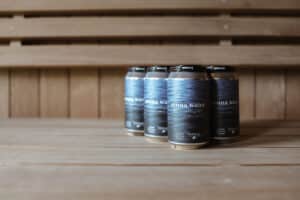We believe that winter is meant to be embraced, not endured. The best and most authentic sauna experiences always include a seasonal element of cold. Whether it be a cold shower in between cycles, rolling in a snow bank, or immersion in cold water — hot and cold need one another. Scandinavians and athletes alike have been using the cold plunge practice for centuries, often searching for relief from pain, inflammation, stress, and sleep issues. The benefits are numerous, but that’s a story for another blog.
Today, we’re here to chat through all things winter cold plunge, ensuring your experience as safe as it is beneficial. After guiding thousands of people through the thermal cycle of hot, cold, rest, rehydrate, repeat, we’ve compiled a few tips on how you can seize the season with this practice safely and effectively.
5 Tips for Cold Plunging in the Winter Months (or Anytime, Really)
1. Find Cold Water (or Weather) – Anything sub-60 degrees Fahrenheit is therapeutically sound when it comes to cold plunging. From a brisk alpine lake in the mountains to a frozen hole in the ice that you’ve cut by hand or even your backyard cold plunge tub, there are plenty of spaces whether naturally cool or fabricated with ice that will allow you to experience the benefits of cold water. If the outdoor temps are cool – this counts too!
2. Use the Buddy System – It’s good practice to cold plunge with a friend to ensure safety. Grab a friend (and a little bravery) then hit the cold plunge.
3. Focus on your breath – Try to breathe calmly while you’re in the water. Cold water can give you temporary shortness of breath — practice breathing slowly, deeply, and calmly.
4. Take Your Time – Enter the water slowly, steadily, and gradually. Accept the fact that it is cold! You will learn to accept and appreciate this over time and with practice. If you’re a beginner, consider cold plunging later in the day as our bodies are more sensitive to the cold in the morning.
5. Gear Up – You may want to wear neoprene gloves and booties during winter plunging. It will minimize heat loss and make it a bit easier for plungers. Some may choose to keep their hands completely out of the water for this same reason.
What is Happening to Your Body During Cold Water Immersion?
Ever wonder what the heck is happening to your body during a cold plunge? Here’s a breakdown of what you can expect when you practice cold water immersion from head to toe.
- Brain – You’re flooding your brain with feel-good. Less blood flow to the brain prompts a reduction of cognitive functions. Noradrenalin and serotonin are increased in the brain which has a positive effect on your mood.
- Parasympathetic Nervous System – You know that relaxed feeling you get after you indulge in your favorite meal or you’re walking in nature? That is your Parasympathetic Nervous System or PNS kicking in. When you cold plunge, your PNS is activated and your vagal tone gets a boost. This is the signal for your body to switch into digestion, healing, and repair mode, letting go of all that unnecessary stress and inviting you into a more grounded state. Cool, right?
- Lungs and Respiratory Function- When immersed in cold temperatures, your gasping reflex is naturally triggered. But there’s no need to panic. Short bursts of hyperventilation have been linked to being anti-inflammatory, alkalizing your blood PH, and more. Shortly after immersion, endorphins swoop in, numbing the skin and helping it adjust to the water’s temperature. You’ll notice your breathing and pulse becoming calm with time.
- Heart – Blood flow to the heart and internal organs increases during a cold plunge. The best part? This results in a lower heart rate and risk of stroke.
- Brown Fat – When activated, brown fat uses sugar and fat from the bloodstream as fuel to keep warm. In turn, the production of brown fat aids in the metabolic function of the body, burning calories and boosting your rate of metabolism.
- Muscle Tremors – When brown fat can no longer maintain body temperature, muscle tremors show up to the party. You may notice some shaking or jitters occurring, which is totally normal. Our body is simply trying to regulate our temperature and that process is actually good for us.
- The Sympathetic Nervous System – This is where your fight or flight response takes hold. When this kicks in your adrenalin, noradrenalin, and cortisol increase along with the mood-boosting chemicals in your brain, i.e. – dopamine and endorphins.
- Boosted Immunity – Especially during the cold months, a strong immune system is paramount to staying healthy. When you plunge your body into cold water, your body experiences an increase of white blood cells, monocytes, and a larger antioxidant system.
Who shouldn't cold plunge?
If you have untreated coronary artery disease, untreated high blood pressure, severe heart rhythm disturbances, or if you think you may be pregnant, it is best to avoid cold immersion therapy. (Recommendations by the Danish Heart Association)

Our mission is to guide others so they can find rest, rejuvenation, and mind/body care through the cultural gift of sauna. Safety is always top of mind whether we’re guiding sessions at our experiences, sharing information on our platform, or participating in the thermic cycle ourselves. With these recommendations, you’ll be well-equipped to make the most of the winter temperatures for years to come!
Want to plunge with the experts? Join us for our Community Cold Plunge right here in Duluth, MN the second Sunday of every month.
For more winter swimming tips, check out one of our favorite resources from Dr. Susanna Søberg. “There is nothing – no medication, no other form of exercise – that can shock you out of your head and back into your body like cold.”









